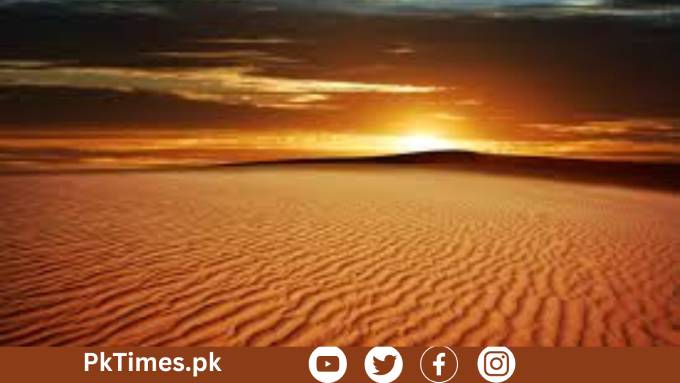Exploring the Deserts of Pakistan: Pakistan, with its diverse geography encompassing majestic mountains, lush valleys, and arid plains, is a land of remarkable contrasts. Among its many natural wonders are its deserts, vast expanses of barren land that possess a unique beauty and allure. In this blog, we embark on a journey to explore the deserts of Pakistan, delving into their rich history, diverse ecosystems, and cultural significance.
Understanding Pakistan’s Deserts
Deserts, characterized by their arid climate and sparse vegetation, cover a significant portion of Pakistan’s landscape. The country is home to several major deserts, each with its own distinct features and attractions. From the golden sands of Cholistan to the vibrant culture of Thar, Pakistan’s deserts offer a glimpse into the country’s rich natural heritage.
Cholistan Desert: Land of Endless Sands
The Cholistan Desert, located in southern Punjab, is a vast expanse of sandy terrain dotted with rolling dunes and scrub vegetation. Despite its harsh environment, Cholistan is home to a diverse array of wildlife, including desert foxes, gazelles, and migratory birds. The region’s cultural heritage, characterized by its vibrant festivals, traditional crafts, and colorful folklore, adds to its allure as a tourist destination.
Thar Desert: Jewel of the Sindh
Stretching across the southeastern region of Pakistan, the Thar Desert is the country’s largest desert and one of the most densely populated deserts in the world. Its unique ecosystem supports a variety of plant and animal species, including the endangered Indian wild ass and the great Indian bustard. The Thar region is also known for its rich cultural heritage, with vibrant communities practicing age-old traditions and crafts such as pottery, embroidery, and camel breeding.
| Aspect | Description |
|---|---|
| Location | The Thar Desert is situated in the southeastern region of Pakistan, primarily in the province of Sindh. |
| Size | It is the largest desert in Pakistan, spanning across approximately 200,000 square kilometers. |
| Ecosystem | The desert hosts a diverse range of flora and fauna, including the endangered Indian wild ass and the great Indian bustard. |
| Cultural Heritage | The region is renowned for its rich cultural heritage, with vibrant communities practicing age-old traditions such as pottery, embroidery, and camel breeding. |
| Attractions | Visitors to the Thar Desert can explore spectacular sand dunes, wildlife sanctuaries, traditional villages, and historic landmarks. |
| Tourism Opportunities | Tourism opportunities in the Thar Desert include desert safaris, camel rides, cultural festivals, and eco-tourism initiatives. |
Kharan Desert: A Desert Oasis
Located in Balochistan province, the Kharan Desert is characterized by its rocky terrain, sparse vegetation, and extreme temperatures. Despite its harsh conditions, the desert is home to a variety of desert-adapted wildlife, including the Persian gazelle and the Balochistan black bear. The region’s cultural heritage, shaped by its nomadic tribes and ancient trading routes, adds to its mystique and allure.
Nushki Desert: Hidden Gem of Balochistan
Nestled in the rugged landscape of western Balochistan, the Nushki Desert is a land of stark beauty and untamed wilderness. Its rolling sand dunes, rocky outcrops, and vast salt flats create a mesmerizing backdrop for adventurers and nature enthusiasts alike. Despite its remote location, the Nushki Desert is home to a diverse array of flora and fauna, including rare desert plants and elusive wildlife.
| Aspect | Description |
|---|---|
| Location | The Nushki Desert is located in the western region of Balochistan, Pakistan, bordering Afghanistan to the north and Iran to the west. It is situated in the Nushki District of Balochistan. |
| Size | Extending over an area of approximately 15,000 square kilometers, the Nushki Desert is one of the prominent deserts in Pakistan. Its vast expanse encompasses a variety of landscapes, including rolling sand dunes, rocky outcrops, and expansive salt flats. |
| Terrain | The terrain of the Nushki Desert is characterized by its diverse topography, ranging from undulating sand dunes to rugged mountainous regions. Rocky outcrops and barren plains dominate the landscape, interspersed with patches of sparse vegetation adapted to the arid conditions. |
| Flora and Fauna | Despite its harsh environment, the Nushki Desert supports a surprising diversity of desert-adapted plant and animal species. Hardy shrubs, thorny bushes, and drought-resistant grasses dot the landscape, providing crucial habitat and food sources for wildlife. Reptiles such as lizards and snakes are common inhabitants, along with small mammals like desert foxes and rodents. Bird species such as the Houbara bustard and various migratory birds are also found in the region. |
| Cultural Significance | The Nushki Desert holds significant cultural importance as it is home to nomadic tribes and ancient trading routes that have traversed the region for centuries. Indigenous communities, including the Baloch and Pashtun tribes, have long inhabited the desert, practicing traditional customs and livelihoods adapted to the harsh desert environment. The desert’s cultural heritage is reflected in its rich folklore, oral traditions, and artisanal crafts passed down through generations. |
| Attractions | The Nushki Desert offers a wealth of attractions for adventurers and nature enthusiasts. Visitors to the desert can explore mesmerizing landscapes, including rolling sand dunes, dramatic rocky formations, and vast salt flats. The region’s unique geological features, such as fossilized dinosaur tracks and ancient petroglyphs, provide insights into the area’s geological and cultural history. Adventure tourism opportunities abound, with activities such as desert trekking, off-road driving, and camping under the starlit skies offering unforgettable experiences amidst the desert’s rugged beauty. |
Conservation Efforts and Environmental Challenges
While Pakistan’s deserts are a source of natural beauty and cultural heritage, they also face numerous environmental challenges, including desertification, habitat loss, and water scarcity. Conservation efforts are underway to protect these fragile ecosystems and promote sustainable development practices that balance environmental preservation with economic growth.
Cultural Significance and Indigenous Communities
The deserts of Pakistan are not only rich in natural beauty but also steeped in cultural significance. Indigenous communities, such as the Baloch and the Thari, have inhabited these harsh landscapes for centuries, developing unique traditions, languages, and lifestyles adapted to their desert environment. Their rich cultural heritage is reflected in their music, dance, art, and architecture, providing a window into Pakistan’s diverse cultural tapestry.
Conclusion
As we conclude our journey through Pakistan’s deserts, we are left with a deep appreciation for the beauty, diversity, and resilience of these remarkable landscapes. From the golden sands of Cholistan to the vibrant culture of Thar, Pakistan’s deserts are a testament to the enduring bond between humans and nature. As stewards of this precious heritage, it is our responsibility to protect and preserve these fragile ecosystems for future generations to enjoy.
Read more: does amazon ship to Pakistan
FAQ’s:
- How many deserts are there in Pakistan?
- Pakistan is home to four main deserts: the Thar Desert, Cholistan Desert, Kharan Desert, and Nushki Desert. These deserts are spread across different regions of the country, each with its own unique characteristics and ecosystems.
- What are the major deserts found in Pakistan?
- The major deserts in Pakistan include the Thar Desert in the southeastern region, the Cholistan Desert in Punjab, the Kharan Desert in Balochistan, and the Nushki Desert in the western part of Balochistan. These deserts vary in size, landscape, and ecological features.
- Why does Pakistan have multiple deserts?
- The presence of multiple deserts in Pakistan can be attributed to its diverse geography and climatic conditions. Factors such as the country’s proximity to arid regions, its mountainous terrain, and the influence of prevailing winds contribute to the formation and distribution of deserts across different parts of Pakistan.


